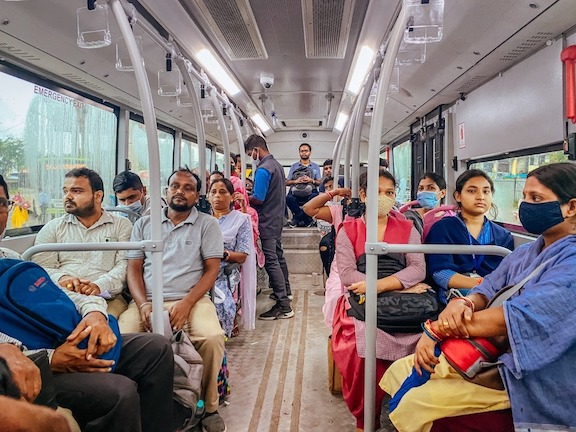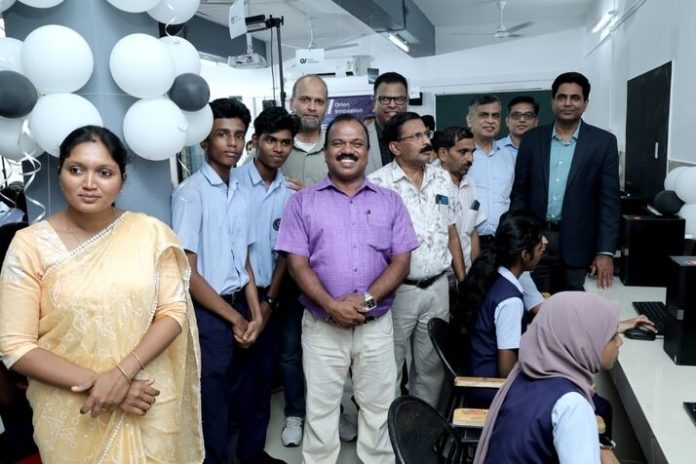CSR support extended to more than 4,000 Students through Shiksha Sambal Diwali Camp 2024
Hindustan Zinc Limited, India’s largest and the world’s second-largest integrated zinc producer, successfully concluded its Shiksha Sambal Diwali Camp 2024, supporting more than 4,000 students from underprivileged rural hinterland across its operational areas. This initiative, part of Hindustan Zinc’s Siksha Sambhal program, an education-focused CSR program, has been operating in Rajasthan since 2008, uplifting the lives of over 2 lakh children annually in underserved rural areas.
The purpose of the camps is to support first-generation learners who are likely to opt out of pursuing studies and a fulfilling career, owing to financial and social constraints. This year’s camp took place in two phases offering academic assistance to Class IX and X students who are in the final stages of finishing their schooling during the festive break. The camps provided support in foundational subjects such as reading, writing, mathematics, and science through structured sessions, featured workbook exercises and practical lab work for science students, along with enhanced library work for mathematics and English.
By focusing on these core subjects, the camp aimed to strengthen student’s understanding and boost their academic performance. Additionally, the program emphasized consistent attendance to maximize learning outcomes, ensuring that every student could benefit from the comprehensive educational support provided. The Shiksha Sambal Diwali Camp 2024 in partnership with Vidhya Bhawan Society reached students across various locations, including Udaipur, Rajsamand, Chittorgarh, Ajmer, and Agucha in Rajasthan. Overall, the camp successfully impacted students, providing essential academic support during a crucial time in their educational journeys.
Hindustan Zinc’s Shiksha Sambal Program is integral to the broader commitment to uplift underprivileged children through education in rural Rajasthan. The company recently signed an MoU with Department of Education, Rajasthan committing an investment of ₹36 crores over the next five years to enhance educational development in the state. The company has established over 1400 Nand Ghars across Rajasthan and Uttarakhand to promote early childhood development of rural children, which has benefitted over 2.5 Lakh women and children. Over the years, the company has significantly transformed the educational landscape of the state with other initiatives such as Unchi Udaan, which supports aspiring IIT candidates from low-income backgrounds, and Jeevan Tarang, which empowers children with disabilities.
Disclaimer: This media release is auto-generated. The CSR Journal is not responsible for the content.
Namo Drone Didi Scheme: A Step towards Modernising India’s Agriculture
The Government of India has launched, the ‘Namo Drone Didi’ scheme, an initiative to empower Women Self-Help Groups (SHGs) under the Deendayal Antyodaya Yojana – National Rural Livelihoods Mission (DAY-NRLM). The Central Sector Scheme has a budget of ₹1261 crores, under which the government seeks to provide drones for agriculture uses to over 14,500 selected Women SHGs between 2024-25 and 2025-26.
The SHGs will use these drones on rent to farmers, for spraying liquid fertilizers and pesticides. The Department of Agriculture & Farmers’ Welfare has issued operational guidelines for the scheme, and has urged the stakeholders to make effective use of these resources, in order to ensure an effective and successful rollout.
How will the Scheme Work?
Under the Namo Drone Scheme, the government has extended significant support for acquisition of drones to the SHGs. The government will cover up to 80 per cent of the total cost of the drone and other required accessories up to Rs. 8 lakh for the selected beneficiary SHGs. In order to cover the remaining cost, the SHG can get loans under the National Agriculture Infrastructure Financing Facility (AIF) with an interest subsidy of 3 per cent.
The drones that the SHGs will be provided with under this scheme will be tailored to meet comprehensive agricultural needs. Each package will include a basic drone equipped with a spray assembly which is necessary for applying liquid fertilisers and pesticides in a field. In addition, the package will also a carrying case, batteries, a dual-channel fast charger, a camera, anemometer, pH meter, and a one-year warranty. In order to ensure uninterrupted operation, SHGs will also receive four extra battery sets, a spare propeller set, and additional nozzles, enabling coverage of up to 20 acres per day.
Skill Development
One of the key highlight of the Namo Didi Scheme is that the initiative will also provide skill training to operated the drone and use it effectively to ensure optimum agriculture output. The government has declared that one member from each SHG will receive 15 days of intensive training, covering both general drone operations and specific agricultural applications like nutrient and pesticide application under the initiative. Another SHG member or a family member with an interest in electrical and mechanical repair will also be offered a training for providing drone assistance. In this manner, the government will ensure that the group has the necessary skills to maintain and operate the equipment effectively.
In order to track progress of the implementation of the scheme and ensure effective monitoring, the government has declared an intent to set up an IT-based Management Information System (MIS), known as the Drone Portal. This portal will manage service delivery, monitor funds flow, and track drone operations, offering real-time data on usage.
The ‘Namo Drone Didi’ scheme holds promise as a sustainable income source for SHGs while bringing advanced technology into agriculture. By supporting women-led SHGs in providing drone services, the government aims to increase crop yield, reduce farming costs, and improve efficiency. This initiative is a significant step towards modernisation of Indian agriculture and empowerment of rural women.
Unique and popular festivals of ‘Devbhoomi’ Uttarakhand
Uttarakhand (formerly known as Uttaranchal) was carved out of Uttar Pradesh on 9th November, 2000. Located in Northwest India, Uttarakhand is one of the most beautiful states crossed by the Himalayas. It is bordered by Himachal Pradesh, Tibet, Nepal and Uttar Pradesh.
Uttarakhand is home to the four most sacred Hindu pilgrimages in India, which are known as the Char Dham. These include Kedarnath, the highest of the 12 Jyotirlingas, Badrinath, temple of the Hindu God Vishnu, Gangotri and Yamunotri, which are dedicated to the scared rivers Ganga and Yamuna. For having several Hindu pilgrimage sites and also because of its stunning natural beauty, Uttarakhand is referred to as ‘Devbhoomi’ or abode of the Gods.
Uttarakhand entices tourists from across the world due to its popular travel destinations like Rishikesh, Nainital, Jim Corbett National Park, Valley of Flowers National Park, Mussoorie, Almora, Dehradun (state capital), Haridwar and several other attractions.
Uttarakhand boasts of unique festivals which are celebrated throughout the year. On Uttarakhand Foundation Day 2024, here is a look into some of the most amazing festivals of the state.
Kumbh Mela
Any discussion about festivals of Uttarakhand is incomplete without mentioning Kumbh Mela. This is one of the biggest and the most popular festivals not only of India, but boasts of being one of the largest religious gatherings in the world.
During Kumbh Mela, pilgrims take a dip in the river Ganga with the belief that the holy river will wash off their sins. Kumbh Mela witnesses a crowd of followers, saints, common people, international tourists and visitors, regardless of their caste, creed or gender who take bath in river Ganga, hoping to eliminate the cycle of birth and death.
However, Kumbh Mela is not only restricted to Uttarakhand. This 3-month long festival takes place once in every four years turn by turn in Uttar Pradesh’s Prayagraj (formerly Allahabad), Haridwar in Uttarakhand, Madhya Pradesh’s Ujjain, and Nashik in Maharashtra, i.e., only once in 12 years in any one place. The exact date of the festival is decided as per the Vikrant calendar. The next Kumbh Mela will be held in Prayagraj from 13th January to 26th February 2025.

Magh Mela
Magh Mela is a religious fair which has become one of the most popular fairs in the Uttarkashi district in Uttarakhand. It is also a major source of income via tourism for the state. Magh Mela is hosted normally between 14-21 January, as part of which dolis or palanquins carrying the deity, are carried to the Ramlila Ground.
During this fair, devotees from different places come for Ganga Snan (dip in the holy River Ganga) and for shopping. Villagers from remote areas also come to this fair to sell wool and other handmade products of their respective areas.
People from different parts of Uttarakhand display their local produce and handcrafted items for visitors. Since the fair takes place in January, skiing activities also take place during this time frame in the skiing ground prepared in Dayara Bugyal, a popular trekking and camping destination.

Basant Panchami
The festival of Basant Panchami celebrates the onset of Basant or Spring season. One of the significant festivals observed in Uttarakhand, Basant Panchami marks the end of winter, while welcoming the month of Magh which falls in end of January or early February. On the occasion of Basant Panchami, Devi Saraswati, the goddess of knowledge and music is worshipped.
This festival is marked by wearing yellow coloured traditional outfits, while the local people perform Chounphula and Jhumelia dances and fly kites. Sweet rice or kheer is prepared at home as part of the festival.
Apart from Uttarakhand, Goddess Saraswati is worshipped during Basant Panchami in the states of West Bengal, Odisha, Assam and Bihar.
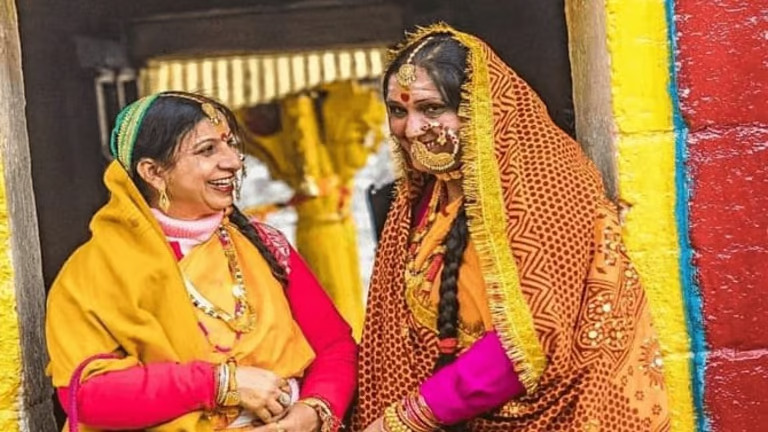
Bhitauli and Harela
Celebrated in the month of Chaitra (March – April), Bhitauli is a festival during which, a married woman’s brother, parents or other relatives visit her and bring with them sweets, fruits and new clothes. A newly married girl receives her first Bhitauli in the month of Baisakh (April-May), after which it is given each year in the month of Chaitra.
Bhitauli revolves around agriculture where women sow seeds in the soil and by the end of the festival they reap the harvest which is called Harela. This allows them to test the quality of their seeds.
Harela means “day of green” and is a Hindu festival celebrated in the Kumaon region of Uttarakhand.
Harela, which is celebrated in the Shravan month (July-August) of Hindu calendar marks the advent of the rainy season and it also commemorates the wedding of Lord Shiva and Parvati. On this day, people make small Dikars (small idols of gods and goddess made of clay) of Gauri, Maheshwar, Ganesha, to worship them. The bullocks are also given rest on this day and the Harela is sent to friends and family. The festival is significant because it provides an opportunity to the cultivator to test the quality of seeds that he has in his stores.
During Bhitauli, the local people start planting seeds in small pots or fields and water them daily. On the day of Harela, the saplings are worshipped and sowed in the fields. Local people celebrate this festival by cleaning and decorating their homes with greenery and flowers. Homemade traditional foods such as Bhatt ki Churkani, Baadi, and Gulgula are a part of the festival feast.

International Yoga Festival Rishikesh
Yoga is a popular activity across the world, which is being heavily promoted by Indian Prime Minister Narendra Modi. Every year, the Yoga Festival Rishikesh is hosted in the city, which started in 1999. This week-long festival is normally organized in the first week of March.
During this festival, yoga enthusiasts can attend yoga classes hosted by world famous yoga teachers and try various kinds of yoga like Kundlini Yoga, Iyengar Yoga, Kriya Yoga, Naad Yoga, Ashtang Vinyasa Yoga, Hath Yoga, Power Yoga, Jivamukti Yoga and Raj Yoga.
Apart from yoga, meditation classes are also held. The International Yoga Festival Rishikesh experiences footfalls from across the world with people from various countries and religions attending it.
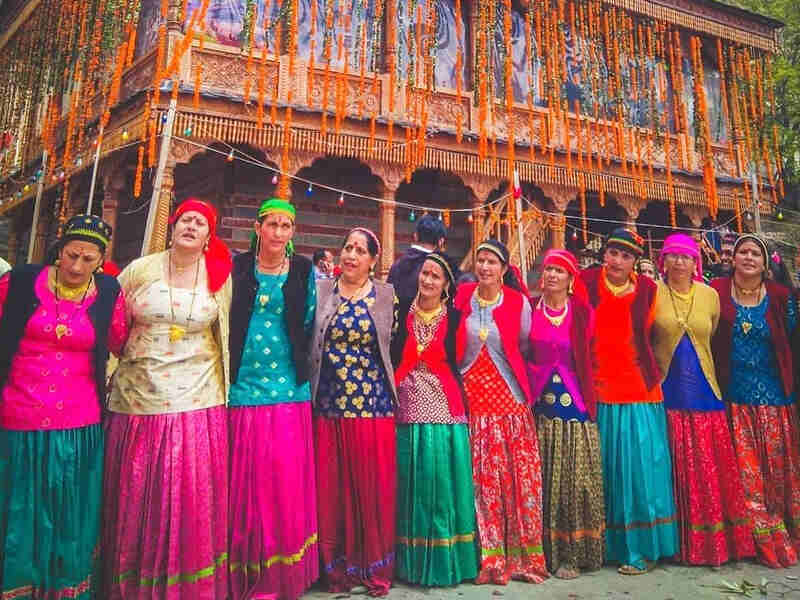
Bissu Mela
Organized in the Chakrata Block of Dehradun in the harvest season during mid-April, Bissu Mela is a fair celebrated by the Jaunsari tribe. The Jaunsari tribe and their festival’s history can be traced back to the Pandavas.
This fair is celebrated for over the period of a week in virtue of a good harvest season in Uttarakhand. Villagers come together to worship ‘Santoora Devi’, which is an incarnation of Goddess Durga. In this fair, the local people dance with folk music wherein men and women wear traditional clothes and indulge in a feast comprising traditional delicacies.
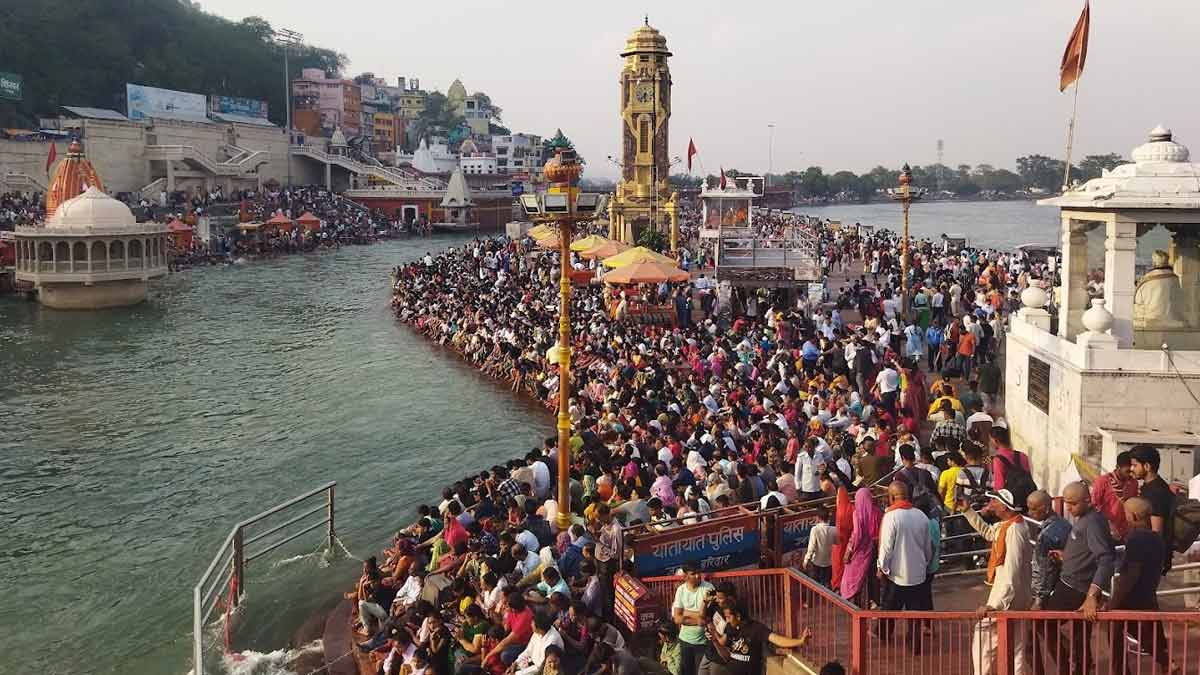
Ganga Dusshera or Dasar Festival
Celebrated in Uttarakhand, Uttar Pradesh, Bihar, and West Bengal Ganga Dusshera or Dasar Festival is observed in the month of Jyestha (May-June) as per the Hindu calendar. The Holy Ganga River is worshipped during the 10-day-long festival. As per Hindu mythology, on this day, the holy River Ganga descended from the heaven to earth.
This festival in Uttarakhand starts on the Amavasya night (new moon) of Hindu calendar and ends on Dashami tithi (10th Day). During Ganga Dusshera, aarti is performed on the banks of the river in the popular pilgrimage destinations of Haridwar and Rishikesh and Uttar Pradesh’s Prayagraj (formerly Allahabad).
The purpose is to cleanse one’s soul by taking bath in the sacred River of Ganga for ten consecutive days. After taking bath, the devotees meditate on the banks of the Ganga River. In the evening earthen lamps are floated in the river along while devotees sing devotional songs.
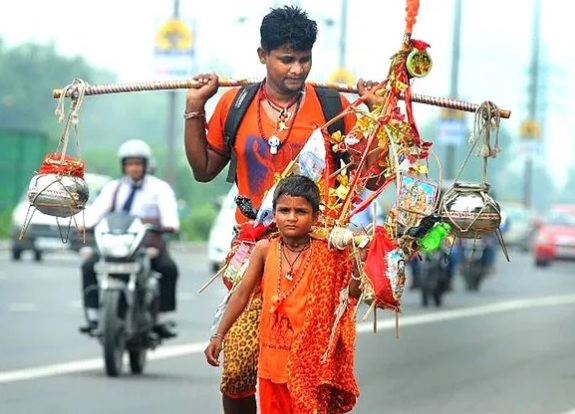
Kanwar Yatra
The onset of the Hindu month of Shravan (July) marks the commencement of the ‘Kanwar Yatra’ sacred pilgrimage journey in Uttarakhand. During the month-long pilgrimage, devotees of Lord Shiva from across India travel to the banks of the River Ganga (cities like Haridwar, Gangotri, Gaumukh, etc) and carry back sacred water from the Holy River to a Shiva temple in pitchers carried on their shoulders using a bamboo pole, known as a Kanwar. Devotees also carry their deity on the Kanwar and travel to the holy river bare feet.
This festival witnesses large camps and gatherings in Haridwar and Gangotri with makeshift accommodations that are constructed across the journey for the Kanwarias to rest. Devotees mostly come from the surrounding states of Delhi, Uttar Pradesh, Haryana, Rajasthan, Punjab, Bihar and some from Jharkhand, Chhattisgarh, Odisha and Madhya Pradesh. Kanwar Yatra is one of the biggest human gatherings in India.

Ghee Sankranti
Celebrated on the first day of the month of Bhado, (usually in August), Ghee Sankranti is a festival of gratitude for agricultural prosperity and the abundance of crops, fruits, vegetables, and milk products. Ghee is considered to be a symbol of purity, prosperity, and health. Ghee Sankranti is also known as Olgia or Ghee Tyar in some regions.
During this festival, local people of Uttarakhand exchange gifts and eat delicious dishes made with ghee on this day. Some of the common gifts are axes, metal calipers, oral harps, and firewood. People also participate in cultural activities such as singing folk songs, dancing folk dances, playing folk instruments, etc. Another custom involves pouring ghee on each other’s foreheads as a gesture of blessing and goodwill. This is especially done by the elders of a family to the youngsters.
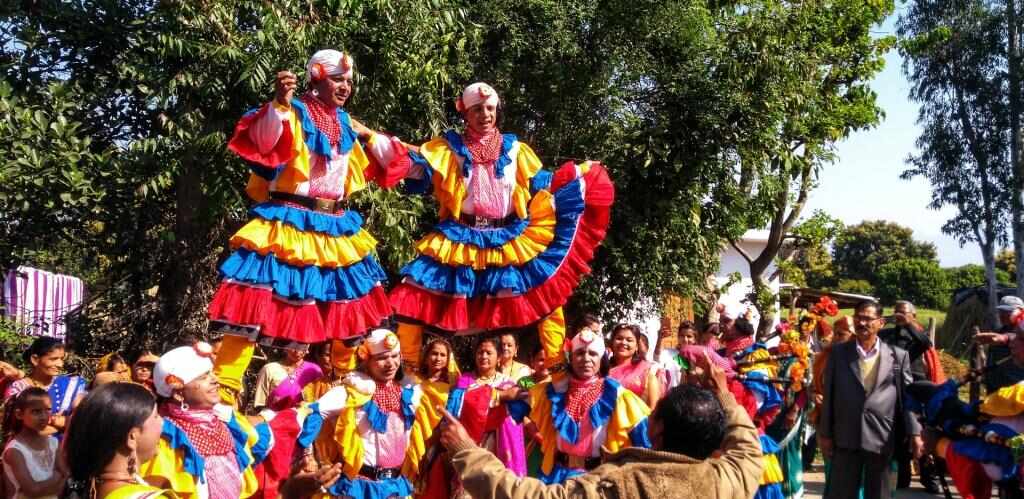
Kandali or Kangdali festival
Kangdali festival (also known as Kandali) is celebrated mostly by the Rung tribe residing in Pithoragarh District between the months of August and October once in every 12 years. Through this festival, the tribal people commemorate the defeat of Zorawar Singh’s army which attacked the region in the late 19th Century. Kangdali is observed in the Chaundas Valley every 12 years when the Kangdali plant blooms.
Kangdali is a week-long festival during which the people of the valley worship the idol of Lord Shiva made with barley and buckwheat and pray for victories over their enemies. This is followed by puja, a ceremonial feast and hoisting of their flag. Victorious cries are uttered, and the scene of resistance is also recreated. The locals even proceed to attack the shrub of Kangdali. Festivities and celebration take place all night where local liquor is consumed.
Reimagining Sustainable Farming: How Corporate Vision and Technology are Reshaping the Coconut Farming Sector
The Coconut tree— aptly called the ‘Tree of Life’, is a vital pillar of the global agrarian economy worldwide, especially in India. India produces 30.93% of the world’s coconuts and contributes around Rs.307,956 million to the country’s GDP. For countless farmers, this centuries-old practice is their primary source of livelihood. However, the industry is grappling with significant challenges, including aging tree populations, fragmented supply chains, and limited access to markets and technology for smallholder farmers.
These issues result in declining yields, inefficiencies, and marginalization of those who rely on coconut farming. Currently, the traditional coconut farming landscape has been characterized by inefficiencies, with farmers reliant on outdated practices, low yields, susceptibility to pests and diseases, and limited market access. To address these issues and unlock the full potential of this valuable crop, a paradigm shift is underway, driven by corporate vision and technological innovation. By investing in research and development, they are developing innovative solutions that enhance productivity, sustainability, and profitability. For instance, through advanced breeding techniques, corporations are creating coconut varieties with superior traits such as higher yield, disease resistance, and improved fruit quality.
Challenges in coconut farming
One of the most significant challenges facing the coconut farming industry is the vulnerability of coconut trees to pests and diseases. Traditional pest control methods often involve the use of harmful chemicals that can have negative environmental consequences. However, corporations are developing innovative pest control solutions that are more sustainable and effective. For example, biological control agents, such as beneficial insects and microorganisms, can be used to target specific pests without harming beneficial organisms.
Additionally, advanced monitoring techniques can help detect pests and diseases at an early stage, allowing for timely intervention and reducing the need for excessive pesticide use. Companies are also promoting sustainable farming practices that minimize environmental impact and ensure long-term viability. This includes initiatives such as organic farming, agroforestry, and water conservation.
The enabling efforts of Corporates is poised to revolutionize the coconut farming industry. AI-powered platforms analyse complex variables like weather patterns, soil moisture, and pest infestations, providing personalized recommendations to optimize crop growth and reduce losses. The adoption of precision agriculture technologies, including drones, satellite imagery, and IoT sensors, enables farmers to monitor their crops in real-time and make data-driven decisions. This precision approach helps optimize resource use, reduce waste, and improve crop health.
Additionally, blockchain technology enhances traceability, transparency, and accountability throughout the supply chain, ensuring authenticity, quality, and compliance with sustainability standards, ultimately transforming the industry, empowering farmers, and promoting sustainable practices that benefit the environment and local communities.
Coconut farming industry undergoing transformation
The coconut farming industry, long perceived as labour-intensive and yielding limited returns, is undergoing a transformative revolution through the integration of digital tools, data-driven decision-making, and a renewed corporate commitment to sustainability and farmer empowerment. Digital platforms provide real-time insights on soil health, weather patterns, and market trends, enabling farmers to make informed decisions, while precision agriculture techniques facilitated by drones and satellite imaging optimize irrigation and fertilization, minimizing environmental impact.
Corporate entities are driving this transformation, investing in sustainable practices and farmer empowerment programs to ensure a stable supply chain and contribute to local community well-being. This modernized approach improves yields and quality, enhances farmers’ economic prospects, and attracts younger generations to the profession. As the industry evolves, its potential to contribute to global food security, rural development, and environmental stewardship becomes increasingly evident, poised to shed its traditional image and emerge as a vibrant, resilient, and sustainable sector.
As we celebrate World Coconut Day this year, it is extremely vital that we acknowledge the profound importance of the Tree of Life, which provides food, fuel, shelter, and income for countless families. By energising the coconut farming community, we can unlock its full potential, ensuring the long-term sustainability of this vital industry.
Views of the author are personal and do not necessarily represent the website’s views.
 Amit Bhasin is the Chief Legal Officer, Group General Counsel, and Secretary of the CSR Committee at Marico Limited. He is part of the Executive Committee of Marico Limited and is responsible for Legal and Corporate Affairs Function for Marico Group both in India and International markets. Amit Bhasin is member of Governance Committee of Marico and also anchors Corporate Social Responsibility function of Marico. With 19+ years of experience, Amit is an active member of various industry bodies, including FICCI FMCG Committee.
Amit Bhasin is the Chief Legal Officer, Group General Counsel, and Secretary of the CSR Committee at Marico Limited. He is part of the Executive Committee of Marico Limited and is responsible for Legal and Corporate Affairs Function for Marico Group both in India and International markets. Amit Bhasin is member of Governance Committee of Marico and also anchors Corporate Social Responsibility function of Marico. With 19+ years of experience, Amit is an active member of various industry bodies, including FICCI FMCG Committee.
0.6 Million Lives Transformed through Investment in Healthcare, Education, and Sustainability as part of CSR of Finance Company
Muthoot Finance, India’s largest gold loan NBFC continued to strengthen its commitment to socio-economic development through its Muthoot Social Responsibility (MSR) initiatives in FY 2023-24. During FY24, the company spent more than Rs. 1000 million in various community-focused projects, positively impacting the lives of more than 0.6 million people through a comprehensive and multi-faceted approach.
Continuing the legacy since the inception of The Muthoot Group in 1887, uplifting the society and fostering sustainability are deeply ingrained in Muthoot Finance’s organizational DNA. The CSR initiatives were focused on offering holistic development by focusing on key areas such as healthcare, education, livelihood support, renewable energy, promoting sports talent, supporting artists of India, wildlife conservation and other infrastructural development. The initiatives were spread across all states and union territories.
Muthoot Finance’s CSR activities also align with almost 12 of the United Nations Sustainable Development Goals (UNSDGs), including UNSDG 1 (No Poverty), UNSDG 2 (Zero Hunger), UNSDG 3 (Good Health and Well-being), UNSDG 4 (Quality Education) amongst many others. With education as one of the primary focus area, the company is proud to report that about 75% of its CSR budget was spent on bridging the educational gap for talented yet underserved children in the country. The initiatives included construction of new academic institution infrastructure, donation of school stationery, construction and renovation of Smart Anganwadis, higher education scholarships amongst others. Almost, Rs. 10 crores were spent on supporting sports activities and sportsmen to represent India in global events. Muthoot Finance further extended its support to a plethora of species of flora and fauna at Tipeshwar Wildlife Sanctuary and Melghat Tiger Reserve by installing solar pumps. This helps in combating challenges posed by climate change and providing consistent water supply throughout the year.
Mr. George Muthoot George, Deputy Managing Director, Muthoot Finance, said, “As a strong believer of the values and ethos of The Muthoot Group of giving it back to society, we are happy that we were able to make a small difference at our end in FY24. Aligned with our three focus areas – Education, Healthcare, and Environment – we are emphasizing on multiple initiatives to lay the groundwork for solving a myriad of various issues. The key objective behind our CSR initiatives is to be a catalyst for social development, contributing to sustainable economic growth of India, and further creating an Atmanirbhar Bharat. As a trusted NBFC, we will continue to prioritize programs and initiatives to enhance economic and social well-being, striving for a harmonious balance between corporate practices and community welfare.”
Under the series of these initiatives, some notable activities included:
– Healthcare: Muthoot Finance aims to contribute significantly towards strengthening India’s healthcare framework. As part of its flagship healthcare initiative – Muthoot Snehashreya, Muthoot Finance touched the lives around one-lakh beneficiaries by helping them with prevention and early detection of kidney-related diseases, diabetes, and hypertension ailments. Additionally, on the account of World Tuberculosis Day, Muthoot Finance in association with Samartha Sahakari Trust and Primary Health Centre Ekkur distributed nutritional kits to various identified TB patients in the Mangalore region. The company celebrated World Health Day by offering free health checkups and medical kits to the people at the bottom of the pyramid. Further, the company also distributed bunker cots and bed mattresses along with pillows to Government Annai Sathya Orphanage Home in Madurai. Distributed advanced microscopes to multiple government hospitals in Madurai with an objective of supporting the National TB Elimination and Control Program.
– Education: In association with Round Table India Association, established smart class facilities at seven identified Government Schools across Five Districts in TamilNadu benefitting more than 4000 students by radically improving their academic performance and enhancing the process of study. Provided Muthoot M George Higher Education Scholarship worth Rs. 10 crores to meritorious students pursuing professional degrees in MBBS, Engineering and BSc Nursing. In the 2023-24, Muthoot Finance recognised the academic achievements of more than a thousand students in 8th and 9th grade across key cities such as Bangalore, Chennai, Madurai, Mangalore, Mumbai, Delhi, Ernakulam, Kottayam and Alleppey. Muthoot Finance allocated more than Rs. 2 crores as part of school scholarships initiative.
– Promoting sports: This segment gained significant prominence during the year. The company provided financial backing to multiple young athletes including professional cyclist Mr. Sreenath Lakshmikanth, and Ms. Sini K Sebastian to represent the nation at various National and International Championships. Both of the athletes were able to achieve remarkable success at their respective events. Additionally, in association with FICCI, Muthoot Finance organized Corporate Sports Championship Kochi 2023 by bringing together over 20 leading corporate firms, including major players such as EY, TCS, Lulu Group, and Geojit Financial Services amongst others to foster sportsmanship and unity within the corporate sector. To support the future generation, Muthoot Finance has dedicated budgets for improvement of sports infrastructure of various schools and colleges across the country.
– Improving quality of life: As part of this initiative, Muthoot Finance distributed wheelchairs, battery-operated tricycles and other medical mobility aids and appliance to over 200 differently abled people. It conducted across cities including Delhi, Dadar amongst others with an aim to support their livelihood and allowing them greater access to social life and community engagement. Built a Virtual Reality Interactive Therapy Unit (Blueroom/Sensory room) for the Centre for Empowerment and Enrichment (CEFEE) in Kerala to create equal opportunities for specially abled children. Sewing machines were donated to the persons with disability (hearing impaired) at Nandini Devi Special School for the Deaf & Blind Akhyam Kalyan Samiti Dhenkanal District, Odisha.
– Promoting arts and culture: Through our ‘Muthoot Snehasammanam’ initiative, the company supported 45 veteran artists who carry forward these unique cultural legacies since its inception in 2015. The programme provided essential financial assistance worth Rs. 27 Lakhs in FY24 and a cumulative spend of Rs. 70 Lakhs under this scheme so far.
– Sustainable Livelihood support: Successfully constructed and handed over the newest tranche of 14 houses under the CSR initiative of Muthoot Aashiyana Housing Project in the coastal suburb of Edavanakkad located in Kochi. Distributed fishing utensils to around 200 fisherwomen in Colachel, Kanyakumari District to improve their fishing activities, positively contributing to the socioeconomic development of the region.
– Environment: Installed solar pumps at Tipeshwar Wildlife Sanctuary and Melghat Tiger Reserve in collaboration with the Hope and Helping Hand Society NGO to safeguard natural ecosystems and wildlife habitats. Established a 25 KWp solar power plant in Kerala Museum to preserve the environment through sustainable manufacturing practices. Solar energy is contributing to 50% of the museum’s electricity requirements and is helping in saving Rs. 5 Lakhs every year. Set up a Bio Medical Waste Storage Room at Government Hospital, Madurai District to enable the hospital to effectively store, segregate and manage the bio waste accumulated on a daily basis.
Disclaimer: This media release is auto-generated. The CSR Journal is not responsible for the content.
CSR: Completion of School Transformation Event at Govt. Model Sanskriti Primary School in Gurugram
Gurugram, India: Ecom Express Limited, B2C e-commerce logistics solutions provider, proudly announces the successful completion of its School Transformation Event held today at the Govt. Model Sanskriti Primary School in Gurgaon. This impactful initiative brought together dedicated Ecom Express’s volunteers who transformed the school’s environment through painting and beautifying various spaces, creating a vibrant atmosphere for students. The event took place from 9 AM to 12 PM, with volunteers arriving early to ensure a smooth start.
Ecom Express’s School Transformation Initiative aimed to enhance the learning environment for underserved students by infusing their classrooms with fresh colours and inspiring designs. Volunteers worked diligently to paint walls, blackboards, windows, and doors, fostering a welcoming and positive learning atmosphere that will encourage creativity and engagement among the children. The initiative not only revitalized physical spaces but also demonstrated Ecom Express’s lasting commitment to community service and social responsibility.
In continuation of a similar transformation effort conducted on the same day last year, Ecom Express has now established this initiative as an annual ritual, reaffirming its dedication to uplifting educational facilities and providing inspiring spaces for young learners.
Ecom Express paid close attention to every detail in the transformation process, assigning volunteers to specific areas and providing guidance from facilitators to ensure a coordinated and impactful outcome. The collaborative efforts resulted in a significant improvement in the school’s aesthetic appeal, ultimately contributing to a more conducive learning environment for students. The enthusiasm displayed by participants and brand exemplified the power of community involvement in creating lasting change.
Ecom Express is committed to uplifting communities through initiatives that enhance educational facilities for future generations. The company believe that every child deserves an inspiring learning environment that nurtures their full potential and actively works toward making it a reality.
Disclaimer: This media release is auto-generated. The CSR Journal is not responsible for the content.
NTPC celebrates 50th Raising Day, marking five decades of powering India’s Growth
New Delhi, India: NTPC Ltd, India’s largest integrated power utility, today celebrated its 50th Raising Day, marking five decades of remarkable growth, innovation, and contribution to India’s power sector. Shri Gurdeep Singh, CMD hoisted the NTPC flag at the Engineering Office Complex (EOC), Noida in the presence of Directors on the Board and senior officials. Employees from all locations joined the celebrations via video conferencing.
During the occasion, CMD NTPC virtually launched the Hydrogen-fuel buses which are set to operate at Leh. The hydrogen buses represent a significant leap in NTPC’s commitment to advancing clean and green technologies.
Additionally, he announced a major groundbreaking achievement — the successful synthesis of CO2 captured from flue gas with hydrogen produced from a PEM electrolyzer, which was then converted into methanol at NTPC’s Vindhyachal plant.
Both the CO2 capture plant and the CO2-to-methanol plant are the first of their kind in the world, marking a historic step in carbon management and sustainable fuel production, he said.
He further added that NTPC has been working on Gen-4 ethanol, green urea, and Sustainable Aviation Fuel. The company has also developed and tested ‘first indigenous catalyst’ for Methanol Synthesis and made substantial progress with hydrogen, carbon capture, and other innovative technologies, underscoring its commitment to building an environmentally-sustainable future.
NTPC’s 50-year logo reflecting its legacy and contribution in India’s progress was also unveiled on this occasion. The new 50-years logo with infinity loop and fluidic nature signifies the everlasting commitment to growth and excellence and resonates 50-years of powering growth and creating infinite possibilities.
He also recognized the extraordinary achievements of NTPC employees’ children on this occasion. Further, several new IT applications were launched, and a special comic book on NTPC’s Girl Empowerment Mission was released. GEM is NTPC’s flagship CSR program which has benefitted over 10,000 girls from the rural communities.
Reflecting on NTPC’s incredible journey, Shri Gurdeep Singh paid tribute to the visionary leadership of the company’s founders, including Dr DV Kapoor, the founding Chairman, and other pioneers who laid the foundation for the institution.
He added, “NTPC symbolises 50 years of powering growth and our resilience has made us a strong-performing company. As the quest continue to power the future of India, the steady addition to our Renewable Energy footprint, including Nuclear, underscores our ambition to create a sustainable future with infinite possibilities.”
NTPC Ltd. is India’s largest integrated power utility, contributing 1/4th of the power requirement of the country. With a diverse portfolio of thermal, hydro, solar, and wind power plants, NTPC is dedicated to delivering reliable, affordable, and sustainable electricity to the nation. The company is committed to adopting best practices, fostering innovation, and embracing clean energy technologies for a greener future.
Disclaimer: This media release is auto-generated. The CSR Journal is not responsible for the content.
Govt launches PM Vidyalaxmi scheme for students pursuing higher education – How to apply, eligibility and benefits
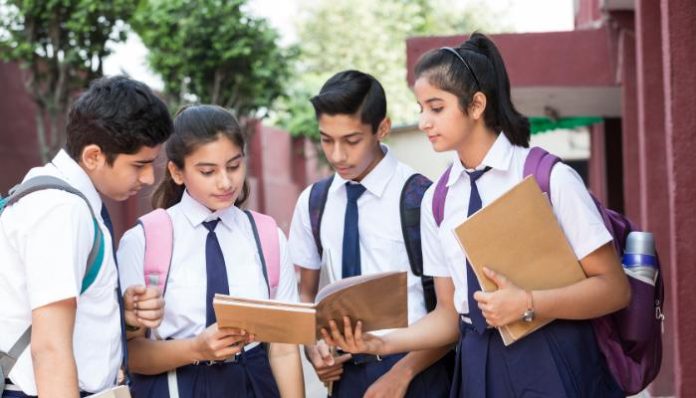
In a move to ensure students can pursue higher education without having to worry about money, the central government has launched a new scheme to financially support meritorious students. PM Vidyalaxmi was approved by the Union Cabinet this week.
Under this scheme, any student who gets admission in quality Higher Education Institution will be eligible to get collateral free, guarantor free loan from banks and financial institutions to cover full amount of tuition fees and other expenses related to the course. The scheme will be administered through a simple, transparent and student-friendly digital system.
The National Education Policy, 2020 recommends that meritorious students in both public and private institutes of higher education should be provided with financial support. So, the newly launched scheme is aligned with NEP 2020.
Higher Educational Institutes that are eligible
As of now 860 top-quality higher educational institutions from across India, covering more than 22 lakh students are eligible to avail benefits of PM Vidyalaxmi scheme providing potential access to benefits for interested students.
Students pursuing courses in top quality higher educational institutions across India, as determined by the National Institutional Ranking Framework (NIRF) rankings – including government and private institutions are eligible to avail benefits of the scheme. The institutes that are ranked within the top 100 in NIRF in overall, category-specific and domain specific rankings; state government institutes ranked in 101-200 in NIRF and all central government governed institutions are eligible.
The central government will update the list of eligible institutes every year using the latest NIRF ranking.
Who can apply and benefits
Students having an annual family income of up to Rs 8 lakhs, and who are not eligible for benefits under any other government scholarship or interest subvention schemes, 3 percent interest subvention for loan up to Rs 10 lakhs will also be provided during moratorium period. The interest subvention support will be given to one lakh students every year.
For a loan amount of up to Rs 7.5 lakhs, a student will be eligible for a credit guarantee of 75% of outstanding default. This will give support to banks in making education loans available to students under the scheme.
While all needy students are eligible, those who are from government institutions and have opted for technical or professional courses will be given preference.
An outlay of Rs 3,600 Crore has been made during 2024-25 to 2030-31, and 7 lakh fresh students are expected to get the benefit of this interest subvention during the period.
How to apply
Students can apply on the ‘Vidya Lakshmi’ portal under the Department of Higher Education. Through this portal, students can apply for the education loan as well as interest subvention, through a simplified application process to be used by all banks. Payment of interest subvention will be made through E-voucher and Central Bank Digital Currency (CBDC) wallets.
Step 1: The applicant will have to register and login to the Vidya Lakshmi portal
Step 2: Fill-up the Common Education Loan Application Form (CELAF) by providing all the necessary details
Step 3: After filling the form, the applicant can search for Educational Loan and apply as per his/her needs, eligibility and convenience
Alternatively, the applicant can also search for Educational Loan after login and apply for the suitable Educational Loan by filling the CELAF.

